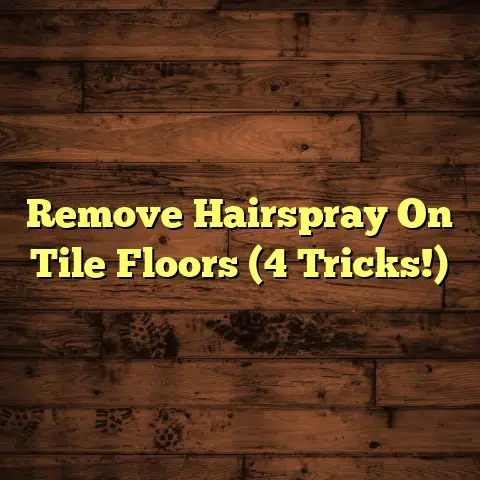Joann’s Peel & Stick Tile? (5 Install Fails!)
Peel & stick tiles, especially those from Joann’s, have exploded in popularity. Why? They promise a quick, affordable, and stylish upgrade for any space. But let me tell you, that “easy” label can be misleading if you don’t know what you’re doing.
I’m here to guide you through the potential pitfalls and show you how to achieve a professional-looking result with your Joann’s peel & stick tile project. Trust me, a little knowledge goes a long way in avoiding these common mistakes.
Section 1: Understanding Joann’s Peel & Stick Tile
Joann’s offers a wide array of peel & stick tiles, from faux wood planks to ceramic-look squares and even decorative patterns. The materials range from vinyl to composite, each with its own level of durability and style.
The beauty of these tiles lies in their simplicity. No messy mortar, no specialized tools (usually), just peel off the backing and stick them down. This makes them ideal for DIYers looking to tackle a weekend project without breaking the bank.
They’re also incredibly versatile. I’ve seen them used in kitchens (backsplashes, not floors!), bathrooms (again, walls are better than floors in high-moisture areas), accent walls, and even to revamp furniture.
However, it’s important to be realistic about their limitations. Peel & stick tiles are not a substitute for traditional tile in high-traffic or wet areas. Think of them as a stylish, temporary solution rather than a permanent fixture.
Section 2: Preparation is Key
This is where most DIYers stumble. You might be tempted to skip this step and jump right into sticking tiles, but trust me, proper surface preparation is the foundation of a successful installation.
First, you need to clean the surface thoroughly. I recommend using a degreaser like TSP (trisodium phosphate) to remove any grease, dirt, or wax. Rinse well with clean water and let it dry completely.
Next, repair any imperfections. Fill cracks or holes with a patching compound and sand it smooth. Remove any old flooring or adhesive residue. I’ve had good luck with citrus-based adhesive removers, but always test in an inconspicuous area first.
The condition of the subfloor is crucial. Uneven surfaces will telegraph through the tiles, creating an unsightly and potentially unstable installation. If your subfloor is significantly uneven, you may need to apply a self-leveling compound. I’ve used Ardex Feather Finish with great success for minor imperfections, but consult a professional for major leveling issues.
Remember, peel & stick tiles are only as good as the surface they’re applied to. Take the time to prepare properly, and you’ll be rewarded with a long-lasting and beautiful result.
Section 3: Common Installation Fail 1: Not Measuring Accurately
I can’t stress this enough: measure twice, cut once! Inaccurate measurements can lead to uneven tile placement, unsightly gaps, and a whole lot of frustration.
Start by measuring the length and width of the area you’re tiling. Add a little extra (about 5-10%) to account for cuts and waste. I always tell my clients to buy an extra box of tile just in case. It’s better to have too much than not enough.
Use a level and chalk line to create a grid on your surface. This will help you keep your tiles straight and aligned. I prefer using a laser level for larger areas, as it provides a perfectly straight line.
Consider the tile size and layout pattern. Will you be using a straight lay, a staggered pattern, or something more intricate? Each pattern requires different measurements and cuts.
For example, if you’re using a staggered pattern, you’ll need to calculate the offset and adjust your measurements accordingly.
Here’s a simple tip: dry-fit the tiles before you start sticking them down. This will give you a visual representation of the layout and allow you to make adjustments before it’s too late.
Ignoring this step is like trying to bake a cake without a recipe – you might get lucky, but chances are it’ll be a disaster.
Section 4: Common Installation Fail 2: Skipping the Layout Plan
Okay, you’ve measured your space, but now what? Don’t just start slapping tiles on the wall! Planning your tile layout is essential for achieving a professional and aesthetically pleasing finish.
Start by finding the center point of your wall or floor. This will be your starting point. Dry-fit the tiles from the center outwards, leaving a consistent gap between each tile. These gaps will eventually be filled with grout (if applicable).
Pay attention to symmetry and aesthetics. Do you want a full tile along the edges, or will you need to cut them? Consider the placement of any obstacles, such as outlets or pipes.
I always recommend creating a sketch of your layout plan before you start. This will help you visualize the final result and avoid any surprises.
Without a plan, you risk misaligned tiles, uneven cuts, and an overall unprofessional look. I’ve seen homeowners end up with tiny slivers of tile along the edges because they didn’t plan properly.
Imagine trying to assemble a puzzle without looking at the picture on the box. You might eventually get it done, but it’ll take a lot longer and the result might not be pretty.
Section 5: Common Installation Fail 3: Ignoring Temperature and Humidity
Peel & stick tiles are sensitive to temperature and humidity. Extreme conditions can affect the adhesive properties, leading to installation failures.
The ideal temperature for installation is typically between 65°F and 75°F (18°C and 24°C). Avoid installing tiles in direct sunlight or in extremely cold or humid conditions.
Check the humidity level in your room using a hygrometer. The ideal range is typically between 30% and 50%. If the humidity is too high, use a dehumidifier to bring it down.
Why does this matter? When it’s too cold, the adhesive can become brittle and less sticky. When it’s too hot, the adhesive can become too soft and gooey. And when it’s too humid, the adhesive may not bond properly to the surface.
I once had a client who installed peel & stick tiles in their bathroom during a heatwave. The tiles started peeling off the wall within a few weeks because the adhesive couldn’t handle the high temperature and humidity.
If the conditions are less than ideal, consider delaying the installation until the temperature and humidity are within the recommended range. You can also try using a stronger adhesive, but always test it in an inconspicuous area first.
Don’t let the weather ruin your tile project. Pay attention to the temperature and humidity, and you’ll be well on your way to a successful installation.
Section 6: Common Installation Fail 4: Not Applying Enough Pressure
This might seem obvious, but you’d be surprised how many people don’t apply enough pressure when sticking down their tiles. A strong bond is essential for preventing the tiles from peeling up over time.
After peeling off the backing, position the tile carefully and press it firmly into place. Use a hand roller or a rubber mallet to apply even pressure across the entire surface of the tile.
I recommend using a hand roller specifically designed for flooring. It’s wider and more effective than a regular paint roller.
Pay particular attention to the edges and corners. These are the areas that are most likely to peel up if they’re not properly adhered.
Check that the tiles are properly adhered by running your hand over the surface. If you feel any air pockets or loose spots, apply more pressure.
What happens if you don’t apply enough pressure? The tiles may not bond properly to the surface, leading to peeling, bubbling, and an overall unprofessional appearance.
I’ve seen homeowners try to fix this by applying more adhesive, but that’s usually not the best solution. It’s better to start with a clean surface and apply adequate pressure from the beginning.
Don’t be shy about applying pressure. The more pressure you apply, the stronger the bond will be. Think of it like giving a really good hug – you want to make sure it’s firm and secure.
Section 7: Common Installation Fail 5: Overlooking the Grouting Process
While not all peel & stick tiles require grout, applying grout can significantly enhance the appearance and durability of your installation. It fills the gaps between the tiles, preventing dirt and moisture from accumulating.
The most common mistake is skipping grouting altogether. This can lead to unsightly gaps and a less polished look.
Another common mistake is applying grout incorrectly. Use a grout float to press the grout into the gaps, and then wipe away the excess with a damp sponge. Be careful not to remove too much grout.
Follow the manufacturer’s instructions for drying times. Typically, you’ll need to wait at least 24 hours before walking on the tiles or applying a sealant.
Choose a grout color that complements your tiles. A contrasting color can create a dramatic effect, while a matching color will provide a more seamless look. I personally prefer using epoxy grout, as it’s more durable and stain-resistant than cement-based grout.
Grouting can be a messy process, so be sure to wear gloves and protect your surrounding surfaces. I always recommend using painter’s tape to mask off any areas that you don’t want to get grout on.
Think of grout as the finishing touch that ties everything together. It’s like adding the perfect accessories to an outfit – it can take your installation from good to great.
Here’s a step-by-step guide on how to apply grout effectively:
- Prepare the surface: Ensure the tiles are clean and dry. Remove any spacers.
- Mix the grout: Follow the manufacturer’s instructions to mix the grout to the correct consistency. It should be like a thick paste.
- Apply the grout: Use a grout float to press the grout into the gaps between the tiles. Hold the float at a 45-degree angle and work diagonally across the tiles.
- Remove excess grout: Use a damp sponge to wipe away the excess grout from the surface of the tiles. Rinse the sponge frequently in clean water.
- Clean the haze: After the grout has dried for the recommended time (usually 24-48 hours), use a grout haze remover to remove any remaining haze from the surface of the tiles.
- Seal the grout (optional): Apply a grout sealant to protect the grout from stains and moisture.
Table: Common Grouting Problems and Solutions
| Problem | Possible Cause | Solution |
|---|---|---|
| Grout cracking | Improper mixing, excessive drying, movement | Remixer grout, ensure proper mixing ratios, address underlying movement issues |
| Uneven color | Inconsistent mixing, improper application | Remix grout, ensure consistent mixing and application techniques |
| Staining | Porous grout, spills not cleaned promptly | Clean stains immediately, apply a grout sealer to prevent future staining |
| Grout shrinking | Excessive water in the mix, rapid drying | Ensure proper mixing ratios, control drying environment |
| Haze remaining | Improper cleaning, delay in haze removal | Use a grout haze remover according to manufacturer’s instructions, clean promptly after grout application |
Conclusion
So, there you have it – the top 5 installation fails to avoid when working with Joann’s peel & stick tile. Remember, proper preparation and technique are key to achieving a successful and long-lasting result.
Take your time, follow the guidelines I’ve laid out, and don’t be afraid to ask for help if you get stuck. With a little patience and attention to detail, you can transform your space with beautiful and affordable peel & stick tiles.
Happy tiling!
Disclaimer: I am an experienced flooring contractor, but this article is for informational purposes only and should not be considered professional advice. Always consult with a qualified contractor for any specific flooring needs or concerns.





